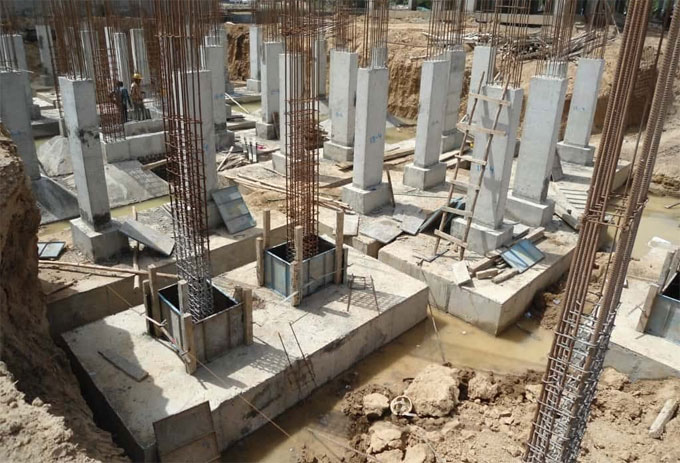
The four types of Shallow Foundation
Shallow foundation is applied in cases where we can find good load-bearing soil at a rather low depth. The foundation depth must meet the safety requirements of the breakdown. That is, after the application of load, the complete structure settlement will be within acceptable limits.
We can use the following four types of shallow foundations: Spread Footing, Combined Footing, Raft Foundation and Ring Foundation.
1. Spread Foundation: You need to spread the load from the column or wall to a larger area, you should use Spread Foundation. The width of the footing area is much wider than the wall or column.
The spread footing that is used to support a wall is called a wall footing or continuous footing. The top of the footing may be stepped or tapered, increasing the width gradually from wall or column to the base. They are of the following types:
a) Strip Footing: This primitive type of footing has been conventionally used in most constructions historically, before more modern inventions. They are mostly made of stones, masonry or concrete. The strip footing that is constructed of stone blocks generally has a stepped top. In modern days, however, the use of strip footing has become next to obsolete. Only in some light loading residential construction is strip footing still used.
b) Isolated Footing: When you provide footings under columns separately in a framed structure, it is called Isolated footing, pad footing or column footing.
In most cases, square footings are used under columns. However, space restrictions may force you to use rectangular footings. In case of circular columns, circular footings may be used, though it is not common. It may be used in special circumstances where construction work is difficult, or the load has to be dispersed very equally.
2. Combined Footing: When two columns are too close to make separate footings for each, then their footings are combined. These may be of the following three types:
a) Rectangular footing: These are the most common types of combined footing. It?s basically two square footings constructed together. This is used when each column is bearing the same load and of the same size.
b) Trapezoidal footing: When the two columns side-by-side are not equal or are not bearing the same amounts of load, then the footing has to be increased in size in the side of the heavier load. This creates a footing with one short side and a long side with slanted other sides. This is a trapezoidal footing. This makes sure that the center of gravity remains in a neutral point.
c) Strap Footing: When a column is situated so near the property line or other obstacle that you cannot create a footing large enough to support it, a strap footing is used. Here, the column beside the problematic column has a bigger, stronger footing. From this, a beam is extended to the smaller and inequal footing of the problem column. This beam supplies the extra load-bearing capacity for the smaller footing. It is called the strap footing system.
3. Raft Foundation: When the site has rather soft soil, then providing footings for each small column proves ineffective - the small footing may sink.
Instead, the whole area is covered in a large slab bearing all the columns - or at least as much as possible. When the footing area exceeds half of the loaded area, it?s called a Raft foundation.
4. Annular or Ring Foundation: When the load is of a round type, and has columns arranged in a circle to support it, like that of a water tank, a ring foundation is used. Here, a ring beam connects all the columns and the foundation is made in a donut shape around the ring-beam. It requires moderately good soil.


